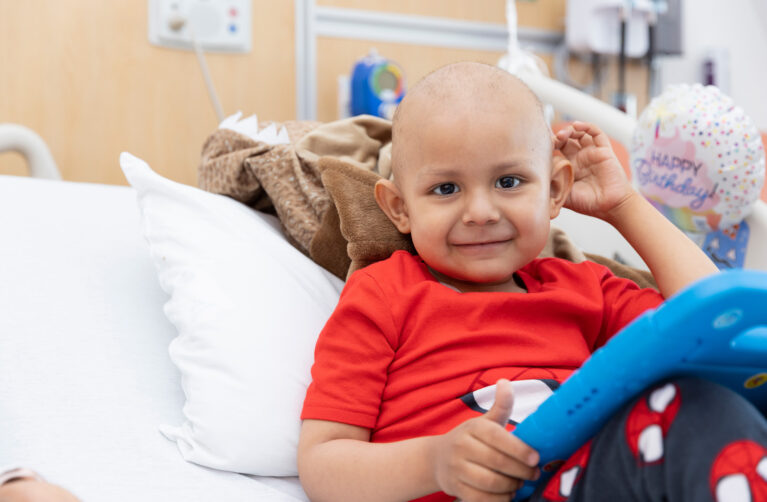Lydia Lee of Palo Alto was 6 years old when she experienced the first warning signs of cancer. “I remember how it started,” she says. “It was November of 1990. I was at school, and I felt a pain in my neck. It became so unbearable that I had to go home.”
Lydia’s parents took her to a local clinic, where doctors discovered a lymph node abnormality and referred her to the pediatric oncology experts at Stanford. Lydia’s primary physician was Michael Link, MD, one of the country’s foremost child cancer specialists.
Tests revealed that Lydia had an unusual variant of acute lymphoblastic leukemia (ALL), a rare, fast-growing cancer of the white blood cells. “Back then, the survival rate for kids with her subtype of ALL was very low,” says Link.
In 1990, the standard treatment for ALL involved several doses of chemotherapy spread out over two years. But Link and other researchers had discovered a close similarity between Lydia’s variant and Burkitt lymphoma, another rare cancer. Instead of two years of chemotherapy, lymphoma patients were being given high doses of chemo over a period of four to six months.
Link recommended trying the more aggressive approach: Lydia would start chemotherapy immediately and complete therapy over the next five months. If her parents consented, she would be one of the first children with her form of ALL to receive this intensive chemotherapy.
“She was almost like a test case,” says her mother, Joanne. “It was a new treatment, and my husband, David, and I had to trust the doctors. We told them, you should do whatever you think is the best for her.”
Lydia got her first round of chemo shortly after being admitted to the Children’s Hospital at Stanford in December 1990. “It was an arduous few months,” she recalls. “It was very painful. My hair fell out, I was throwing up, and I went from 60 pounds down to 30.”
Lydia’s ordeal was also difficult for her little sister and her parents. “David and I went through a real struggle about how we could care for Lydia 24 hours a day and still take care of her sister,” Joanne says.
By June 1991, the chemotherapy had ended, but Lydia continued to receive care to help manage her low blood counts. That month, Lucile Packard Children’s Hospital opened, and she was among the first patients transferred to the brand new facility.
“Dr. Link carried me into the new building,” Lydia says. “I don’t remember much about when I was sick, but I will always remember Dr. Link. He cared. He brought me gifts and made sure I did my homework. There was a deep doctor-patient relationship that continued for many years.”
By December 1991, a year after she started treatment, Lydia was in complete remission, and her life was virtually back to normal. She still needed frequent check-ups, but fewer and fewer as the years went by.
“Children like Lydia are one of the main reasons Packard Hospital was built,” says Link. “We were treating desperately sick patients with regimens associated with potentially life-threatening complications. If they needed intensive care, we’d have to transport them to the pediatric unit across campus at Stanford Hospital. It was like being a tightrope walker without a net. To finally have a full-service hospital with an intensive care unit, surgical rooms, and CT scanners in one building was enormously comforting.”
With deep appreciation for the care that Lydia received at Packard, David and Joanne endowed the Lydia J. Lee Professorship in Pediatric Oncology at Stanford in 2002. The first recipient of the endowed chair was Michael Link.
“My family wanted to give back,” Lydia says. “What better way than to give an endowment to Dr. Link, who was such a big part of my life.”
The Lee Professorship provides salary support for Link and other investigators in the oncology program to search for new and better treatments for leukemias and lymphomas. In addition to the generous endowment, Joanne Lee also volunteers at Packard as a Korean language translator for patients and families.
“The Lees are remarkable people,” Link says. “They’ve become part of the fabric of the Hospital, giving back financially and physically. You can’t ask for more.”
Lydia, now 26, is pursuing a career in public relations. Her prognosis is excellent, and the chance of her cancer recurring is remote. Today, the survival rate for children with Lydia’s rare subtype of ALL is about 80 percent, and what was considered experimental therapy 20 years ago is now the standard treatment.
“What a great thing,” Joanne says. “So many patients have benefited from the research that came from Lydia’s case. But successful research depends on help from the community. If we have the ability to provide support, I think we should.”



